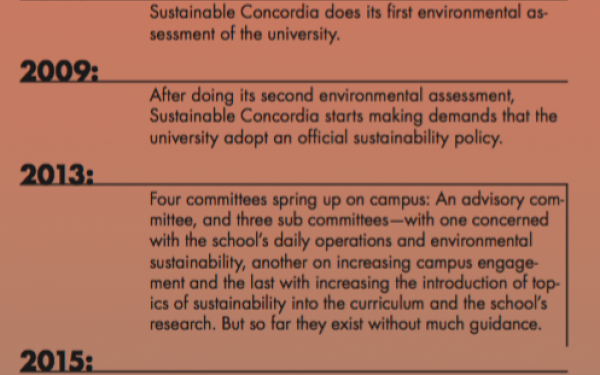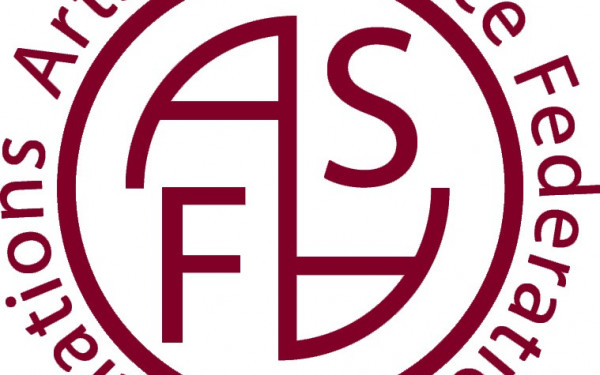How Sustainable Is Concordia?
An institution that spends upwards of $450 million annually can have a huge impact on the future of sustainability, depending on how it chooses to spend its money.
Not only has Concordia University begun to realize how certain energy-saving techniques can be healthy for its coffers, but interest in greener options from the higher-ups is helping create the demand that free-market champions point to.
Questions of sustainability seep into nearly every decision the university makes, and while it’s in everyone’s interest to attend a more eco-friendly school, the changes needed to clean up the school’s act—and its image—require reams of research and planning.
To that end, Sustainable Concordia, a non-hierarchal organization acting as an umbrella for all ConU’s green initiatives, will be releasing a report on the state of our sustainability this spring.
Ashley Finlayson, coordinator of the report, said the university is heavily invested in the results.
“Their big concern is that they want the results that come out to be in line with the strategic plan,” she said.
REACH FOR THE STARS
The Sustainability Report uses the Sustainability Tracking and Rating System, an American framework that gauges how institutions are doing compared to other schools.
Created by the Association for the Advancement of Sustainability in Higher Education, the framework is the most developed set of criteria used by multiple institutions, but it still needs improvement.
“Unfortunately, all the great stuff Concordia is doing is not addressed in STARS,” said Finlayson. “Waste is an area where Concordia is doing really well, but because of the criteria that STARS is asking for—they’re asking, instead of diverting waste, to reduce waste—we now get fewer points.”
With new buildings going up, reducing total waste doesn’t seem viable for the school. Instead, the focus has been on increasing the percentage of composted waste, a factor not evaluated by STARS.
Another issues with the system is the lack of concrete planning for sustainable policy to come to fruition.
“One of the problems with the 2009 assessment was the model in terms of how recommendations would translate into action,” said Sustainable Concordia’s R4 and environmental coordinator Faisal Shennib.
What the report has found, however, is that the greatest potential for movement is when the administration actively coordinates with students and takes part in student initiatives.
“Once they see these initiatives and everyone is on the same page, the governance will get to pick up a lot faster,” said Finlayson.
LEARNING THE LANGUAGE
Becoming fluent in the language of sustainability is crucial to Concordia’s green goals. Several initiatives, such as employee training and sustainability in the curriculum, are underway to increase linguistic understanding.
“There’s a general employee-training session that Concordia University staff go to and [Sustainable Concordia] participates in that,” said Shennib.
“We have a program called the Ambassadors Program which is about talking to the people in the departments about things they do to be more sustainable like double-sided printing, turning off lights, light bulbs, all that jazz.”
With the recent addition of a minor in sustainability, an assessment has been completed on all courses that cover sustainability, as well as all those that have the potential to.
Finlayson says that the university is moving in the right direction, with the Engineering and Computer Science Department being very interested in developing a specialized program.
REUSABLE MUGS
In the Sustainable Concordia office sits disposable coffee cup troll/mascot Uggie the Muggie, a patchwork of Tim Horton’s brown and Starbucks green. He represents the estimated over 100 cups that are thrown out at Concordia every hour.
In another corner sits sustainability mascot Huggie the Muggie, who embodies SC’s gradual campaign to increase the number of mugs on campus.
The ultimate vision for the mug campaign is to collect a fleet of reusable mugs that will be available for on-campus pickup and drop-off, where they will be washed and sterilized for re-use.
For now, Shennib prescribes applying the same social pressure that people now feel at the grocery store when asked if they have their own bags, but retailers are hesitant about scaring people off.
WATER BOTTLES
“Last year the university agreed to do a phase-out of the sales of bottled water from vending machines initially, and then from the vendors,” said Shennib. “That would happen after university buildings are fit with fountains that have fillers.”
This is easier said than done. With all buildings equipped with different kinds of fountains, and the desire to have one company complete all the retrofitting, the process is moving slowly.
Three phases are planned until Concordia can totally remove bottles from vendors and vending machines.
Concordia will be embarking on a three-phase plan to convert the fountains, building by building. It will likely still be four years before the full plan comes to fruition, however, said Shennib.
CHARTWELLS
Campus food service provider Chartwells was challenged by the 2009 report to “increase the volume of local, organic, seasonal and fair-trade food supplied, vegetarian and vegan options, introduce bulk condiments and reduce overall waste by requiring tray-less dining and reusable containers on campus.”
There has been some improvement in these areas, with 21 per cent of Chartwells food coming from within 100 miles of Montreal, up from 11 per cent in 2008.
“I think the biggest steps [Chartwells] made is in reduction, but they have definitely started using more bulk stuff and they’ve started using compostable items,” said Shennib.
“Although not all of their utensils are compostable yet, I’ve been going and meeting with the Chartwells manager and making sure they get everything to move in that direction.”
SPACE & TRANSIT
Concordia is in the process of recladding the GM Building, work that will cut the building’s energy footprint by 40 per cent. The STARS framework advises all construction follow Leadership in Energy and Environmental Design (LEED) standards, which both the EV Building and PERFORM Centre are built to adhere to.
However, the buildings are not LEED-certified by a third party, and the new GE Building at Loyola was not built according to LEED specifications.
As for Allégo, Sustainable Concordia’s transit limb, the focus right now is on increasing student bike skills and resources. Funded by Facilities Management, Allégo has a number of projects on the go, including hosting workshops and increasing outdoor bike racks on campus.
Along with the Sir George Williams campus co-op Right to Move, Allégo is looking to expand their new co-op Le petit vélo rouge to Loyola, but there are still some hoops to jump through.
“Administration is cautious to give something so valuable in a campus with such restrictive space, so they have to understand where we come from and who we are before they give us something,” said Allégo coordinator Graham Bradley.
“It’s hard to coordinate, because administration can’t always share the details of what they’re doing because of contractual law.”
And therein lies the rub. It’s inevitable that it will take longer than sustainability champions would hope, but it may pick up as the image of sustainability becomes something prospective students care about.
Although the speed of all these changes may depend on cost, the last report suggests that the best work is done when students and governments are on the same page.
Ultimately, Concordia’s path to sustainability hinges on its ability to turn the findings of the report into action—thus the importance of the forthcoming report coming up with solutions for governance and student body to work together towards a more sustainable future.

2_900_528_90.jpg)
_600_832_s.png)


_600_375_90_s_c1.jpg)
copy_600_375_90_s_c1.jpg)
